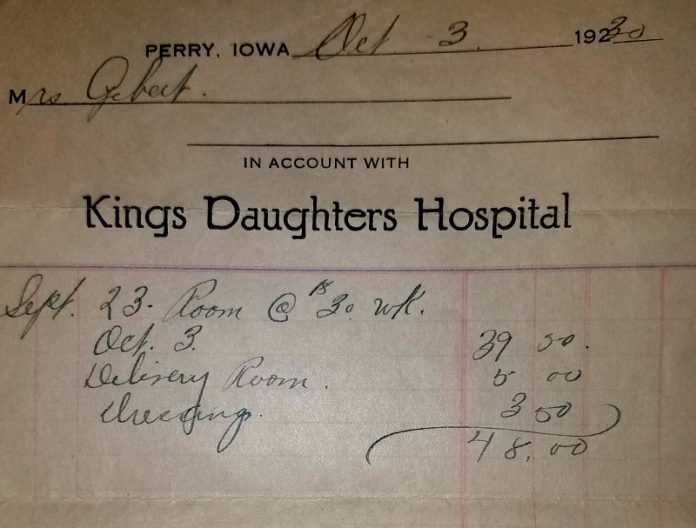
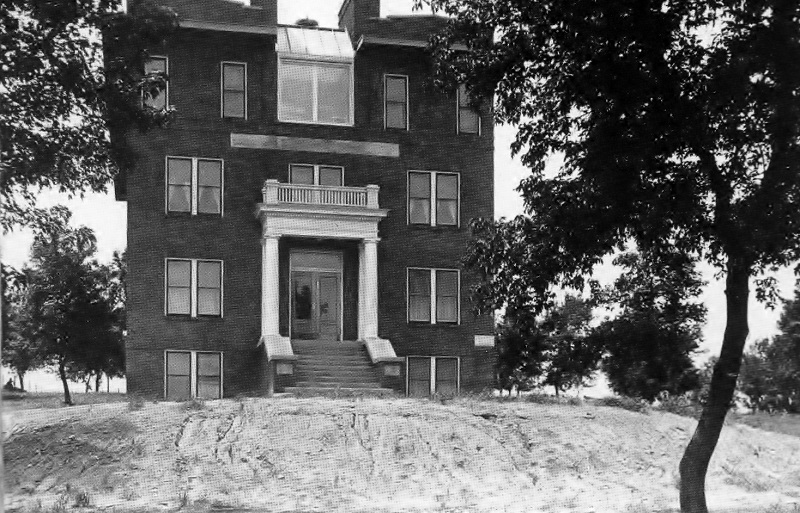
Medical bankruptcy is the most common way to go broke in America today, but it was not always the case that healthcare cost you your life. Janet Llerandi of St. Paul, Minn., just stumbled across proof of our affordable past.
“I just found a receipt,” Llerandi wrote to ThePerryNews.com, “for my mother’s hospital stay at Kings Daughters Hospital, where I was born Sept. 23, 1930. That total bill was $48 for five days.”
Llerandi was born Janet Gebert, the only child of Roy and Margaret Gebert. Her parents were native Iowans, her father hailing from Denison and her mother from Manning.
Janet did not say where she came across the receipt for her birth — she jokingly refers to herself as Janet the $48 baby — but her mother must have preserved it with care nearly 87 years ago.
“I guess I was a bargain,” she said.

But one price in isolation can be misleading. Living occurs in the relation between prices and wages, and prices and wages in September 1930, as America was entering the Great Depression, were low all around.
According to the U.S. Bureau of Labor Statistics, for instance, a pound of flour cost 4 cents in 1930, and a loaf of white bread cost 8 cents, a pound of sirloin steak 47 cents, a pound of sliced bacon 43 cents, a quart of milk 14 cents, a pound of potatoes 3 cents, a can of pork and beans 9 cents and a pound of coffee 38 cents.
Wages were similarly low, according to the same source. For example, hourly wages for bakers in 1930 were 45 cents, shoe salespersons 53 cents, coal miners 92 cents, foundry workers 60 cents, filling station attendants 39 cents, slaughterhouse laborers 45 cents, and workers in the retail trades earned an average of 54 cents an hour.
Data from the U.S. Bureau of Labor Statistics also shows that men who sold men’s clothing earned $39 a week in 1930, and women selling men’s clothing earned $22 a week. Laborers in general-merchandise retailing earned an average wage of $21.07 a week in 1932. These rates are relevant to Janet’s circumstances.
“My dad was the store manager of Montgomery Wards in Perry for a short time,” Janet said, “and then he was transferred to Grand Forks, N.D., then to Billings, Mont., and finally to St. Paul, Minn., where he was regional manager until he became vice president of retail and moved to Chicago.”
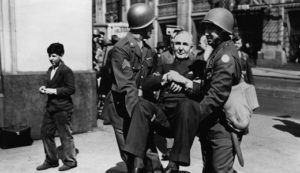
U.S. Army troops seized the Chicago offices of Montgomery Ward and Co. in 1944 because its chairman refused to settle a strike that the Franklin D. Roosevelt administration said hurt the delivery of needed goods in wartime. Janet alluded obliquely to her father’s fortunes in Chicago.
“That didn’t work out very well,” she said of his vice presidency, “and a bunch of executives all resigned over a few weeks. My dad was one of them.”
She said she and her parents then moved back to St. Paul, where her father started a plywood business. Janet lives in St. Paul today, but it was not always so.
“I went to Cuba,” she said, “and worked there as a Spanish/English secretary, met my husband and got married there, and we came back to St. Paul in 1955 before our son, Roy, was born.”

Janet would have lived under the regime of Fulgencio Batista, the military dictator of Cuba who seized power in 1952 and was overthrown by a socialist revolution led by Fidel Castro and Che Guevara in 1959.
Under Batista, Cuba was America’s casino playground, where profits from gambling, prostitution and drugs enriched the American mafia. America’s free markets now seem to have largely mainstreamed those commodities.
Janet did not say what she thinks either of President Obama’s recent relaxation of the nearly 60-year economic embargo of Cuba or of President Trump’s more recent renewal of restrictions on travel and business with the island nation.
She was born in Perry, as her $48 receipt proves, but “I don’t remember Perry,” Janet said, “as I was under a year old when we moved to Grand Forks.”
The Kings Daughters Hospital was built in 1914. It operated as the Dallas County Hospital from 1954 to 1956, when the present location of the Dallas County Hospital was established on 10th Street in Perry. Prior to that, from 1934 to 1954, the Dallas County Hospital was part of the county poor farm, now the site of the Dallas County Human Services Campus.
Janet’s mother, Margaret Gebert, died in St. Paul in 2002. She was preceded in death by Janet’s father, Roy Gebert, whom Janet is probably thinking about today, Father’s Day.
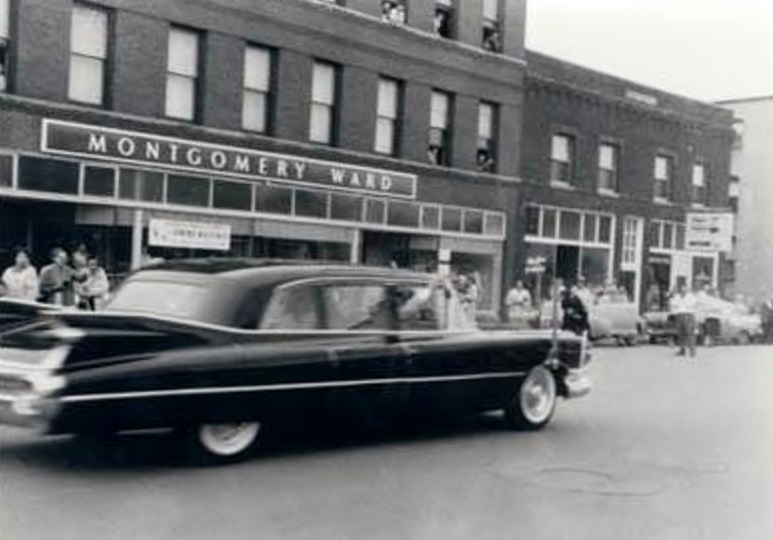
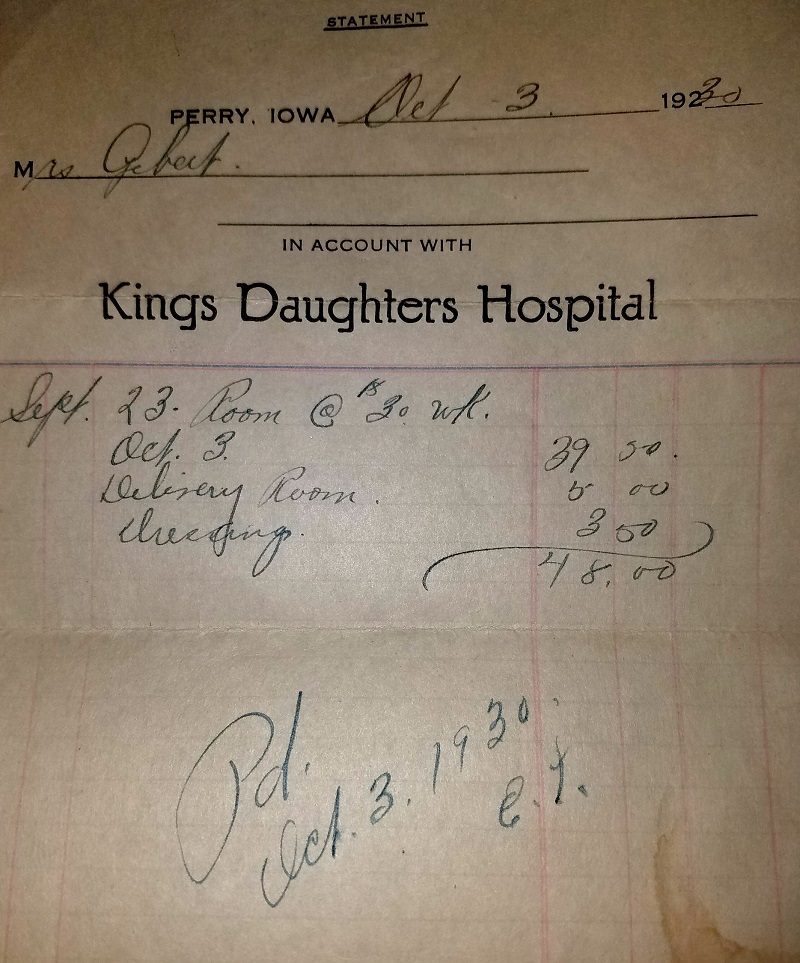
















My grandfather, Eugene Marion Pike, also worked for Montgomery Wards in the 1930s and followed the same path, Grand Forks, Billings, St. Paul, so they may have known each other. But more interested was one of my relatives from my dad’s side, Theo Babcock, who was a nurse at Kings Daughter hospital around 1925. I have pictures of the hospital, several nurses standing by an ambulance during that time.